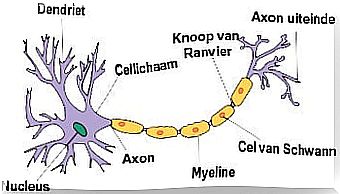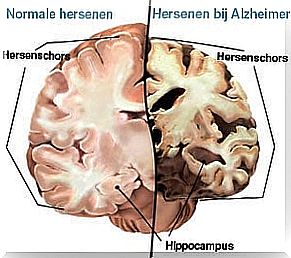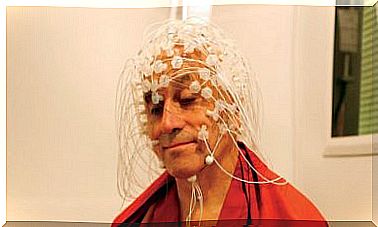The Process Of Alzheimer’s Disease In The Brain

It’s a shame, but while we are all aware of the different types of dementia, we often don’t have any understanding of what goes on in the brain of someone who has it. Therefore, the aim of this article is to explain, as simply as possible, what happens in the brain of someone diagnosed with Alzheimer’s disease.
In addition, I will discuss one of the most recent and most hopeful breakthroughs in Alzheimer’s treatment. This breakthrough, recently published in the journal Nature , is so significant that its results could change the course of Alzheimer’s disease as we know it forever.
The brain with Alzheimer’s disease
When a person is affected by Alzheimer’s disease, there is a severe deterioration of the brain, especially in the hippocampus, the entorhinal cortex, the neocortex (especially the association cortex in the frontal and temporal lobes), the basal ganglia, the locus caeruleus, and the nuclei raphe.
But what is all this? These are different areas of the brain that, at its simplest explained, deal with the learning process, the memory process, and the process of emotion regulation. As is known, all these functions are strongly impaired in patients with Alzheimer’s disease.
The damage to these areas of the brain begins with the formation of amyloid plaques and neurofibrillary tangles (neurofibrillar tangles). However, before we explain what these plaques and tangles are, we need to know what a nerve cell is made of:
- The soma: This is the widened end where the cell nucleus is located and where the information that each nerve cell receives from the other nerve cells around it is stored.
- The axon: this is the extension of the nerve cell that conducts electrical impulses and serves to send information from one nerve cell to another nerve cells.
- Dendrites: These are the small extensions that conduct electrical impulses from other nerve cells to and from the cell body of the nerve cell to which they themselves belong.

The amyloid plaques are structures that accumulate between nerve cells and consist of a protein called beta-amyloid. These structures are surrounded by axons and dendrites that degenerate. This degeneration process is natural in every human brain; it is not pathological.
In addition to axons and dendrites, the structures are surrounded by activated microglial cells and reactive astrocytes, cells that play a role in the destruction of damaged cells. The so-called phagocytic glial cells also play a role. These are responsible for destroying the damaged axons and dendrites, leaving behind only a nucleus of amyloid beta.
The neurofibrillary tangles consist of nerve cells that are on the brink of extinction and contain insoluble intertwined fibers consisting mainly of the tau protein. Tau proteins are a component of microtubules, the neuroskeleton of nerve cells.
During the development of Alzheimer’s disease, the tau protein is phosphorylated, a process in which phosphate groups bind to the tau protein, changing its molecular structure. This structure turns into a series of abnormal fibers that can be found in the soma and dendrites closest to the cells of the cerebral cortex.
Ions ensure that the transport of neurotransmitters through the cell comes to a standstill, causing the tau proteins to curl up and the nerve cell to die. What remains behind are curled up proteins in the brain, the so-called tangles.

The brain with Alzheimer’s and normal brain
Just for a second, didn’t you just say that the nerve cells degenerate? Yes, and this is something that happens during the normal aging process. But in the case of Alzheimer’s disease, the formation of amyloid plaque results from the production of a more toxic form of beta-amyloid, which triggers the death of cells, so we cannot speak of normal aging.
In other words, everyone’s brain has some degree of plasticity; nerve cells that degenerate without causing damage. These nerve cells are replaced by others, without us even realizing that they are no longer there.
Importance of the new treatment for Alzheimer’s disease
The renowned British scientific journal Nature recently published an article called Alzheimer’s disease: Attack on amyloid-β protein . Eric M. Reiman, lead author of this paper, goes into detail about the discovery of new breakthroughs in the treatment of Alzheimer’s disease, or more specifically, the beta-amyloid protein.
Reiman and his colleagues were investigating a new drug that avoids nerve cell destruction and amyloid plaque buildup, which, as we explained above, is believed to be one of the main causes of the cognitive decline associated with Alzheimer’s.
Félix Viñuela, a neurologist and researcher at the Hospital Virgen Macarena in Seville, says that “this drug travels to the brain, binds itself to the structure of that toxic substance and begins to remove it.” In addition, “we have proven that the higher the dose of this drug we administer, the better our patients recover.”
However, the researchers themselves emphasize that, at the moment, this is a study being conducted in 300 hospitals in North America, Europe and Asia, particularly among patients suffering from mild cognitive impairment (MCI) and that although this is an extremely promising breakthrough, there is still a long way to go before the drug can be used in practice and before its long-term effects can be proven.









